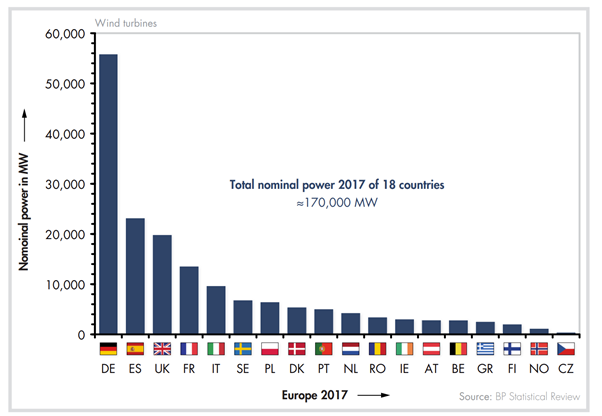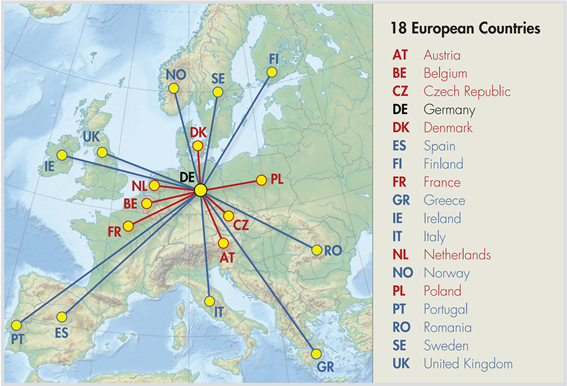The following is a summary of the excellent paper entitled:” Wind energy in Germany and Europe Status, potentials and challenges for baseload application Part 2: European Situation in 2017” by Dipl.-Ing. Thomas Linnemann Dipl.-Phys. Guido S. Vallana published in VGB PowerTech e.V. Essen, Germany, VGB PowerTech 3, 2019.
Wind and solar power are cornerstones of rebuilding the electricity supply system completely into a renewable system in Germany. The plan is replace all conventional conventional power plants such as nuclear, coal and natural gas. The question is with what?
In 2017, the nominal capacity of the German wind fleet increased by a further 12% from 2016 to roughly 56,000 MW (Figure 1 ), 90% by onshore and 10% by offshore wind power. It is interesting to note that the minimum production, PMin of 158MW in 2017 represented only 0.3 % of the installed capacity. The annual minima PMin of the German wind fleet power output was less than 0.5% of the installed capacity during 2010-2017. Also, as electricity generation from wind power expands, the difference between the installed capacity and the annual maximum power output increases, e.g. from 80 % in 2010 to 70% in 2017.

Figure 1 Electricity generation from wind power in Germany from 2010 to 2017. PN is the installed capacity, i.e., the maximum output of all the wind turbines in Germany if all windturbines produced electricity. PMax and PMin are the actual annual maximum and minimum output, respectely. Pm is the average output during a specific year, e.g. in 2017 the average output was 11,720 MW, i.e. 21 % of the installed capacity (56,164 MW).
During a ten day period from January 16 to 25, 2017 the weather in Germany was cold, foggy and windless. The weather conditions resulted in an electricity production from wind wind turbines and photovoltaic (solar panels) systems of only an average of 5 % of the installed capacity and during several days only 2 % of the installed capacity. During the ten-day period, all renewable energy systems (RES) together covered 15% of the demand and produced an average power output of around 11,000MW. During this ten day period the load varied between 42,000MW and 75,000MW, so that available conventional power plants (nuclear, coal and natural gas) had to contribute most to meeting demand with power outputs of 33,000 to 67,000MW. These data shows that a backup system needs to be installed to replace the conventional power plants (nuclear, coal and natural gas) in the future when the conventional power plants today will be phased out.
Also in other countries periods of weak wind occurred, e.g. in Great Britain the wind fleet power output ranged from a few hundred to about 3,000MW, reaching a monthly average of 9% of the installed capacity.
It can be concluded that operating experience from 2010 to 2017 confirms that, wind power has so far not replaced conventional power plant output (nuclear, coal and natural gas) from the security of supply point of view. Furthermore, distribution of wind turbines throughout Germany is, on its own, clearly not a solution for a reliable and secure supply of electricity. Complementary technologies are necessary in conjunction with wind power. This raises the question as to whether wind turbines distributed widely throughout Europe could help. This question will be addressed at the end of this summary.
Figure 2 shows the installed capacity of wind turbines in 2017 and Figure 3 shows a map of the 18 European countries. Germany’s direct neighbours are marked in red, all countries further away in blue.

Figure 2- Nominal capacity of wind turbines in 18 European countries at the end of 2017.

Figure 3- Overview of 18 European countries analysed. Germany’s direct neighbours are written in red, all countries further away in blue. The yellow dots on the map of Europe shows the largest wind farm clusters in 2016.
Figure 4 – shows that the actual electricity produced by wind farms (dark blue areas) is only a fraction of the installed capacity (designated by Nominal power in the figure – light blue). The load (i.e. the energy consupmtion) in the 18 countries varies over the year and is lowest during summer.

Figure 4- Electricity generation from wind power and load in 18 European countries in 2017. ”Nominal power” is installed capacity, i.e. the maximum output of the wind farms.
Figure 5 shows that:
– the secured capacity of the European wind fleet ranges from only 4-5%
– during the period 2015 to 2017 the power output of the European wind fleet ranges from 4 to 63% of the nominal capacity. The extreme variations in power output put severe stresses on the stability of the electric grid and increases the risk for a grid collapse.
– even at European level, dispatchable backup capacity of practically 100% of the nominal capacity of the European wind fleet has to be maintained, as long as its installed capacity, about 150,000+ in Figure 4 has not yet exceeded the annual peak load of all countries concerned, about 350,000 to 450,000 in Figure 4 plus reserves.

Figure 5- Normalised power output of the European wind fleet for the years 2015 to 2017 with three trend lines illustrating the seasonal character of electricity generation from wind power. The secured capacity of the European wind fleet is only 4 to 5% of its installed capacity, PN (see Figure 4) and the capacity factor (the percentage of actual wind energy production related to installed capacity) ranges from 22 to 24%. The trend lines of the European wind fleet of these three years are included for clarity, and illustrate that variations are essentially determined by the annual availability of wind.
Can wind turbines distributed widely throughout Europe help to smooth the electricity need, i.e. can countries which lacks electricity import electricity from countries with electricty surplus?
However, it turns out that if wind conditions in Germany are favourable, then this is also often the case in neighbouring countries and vice versa. Another issue is the grid losses over large distances of about 7 % for transport and distribution of electricity from the power plant to the end consumer. In absolute figures, losses from power transport and distribution of 18 countries in relation to the total annual electric energy fed into the grid amount at present to around 200TWh per year. This is around double last year’s generation of electricity from solar power of these countries, or about 60% of their electricity generation from wind power.
The Federal Association of the German Energy and Water Industries BDEW recently questioned the availability of foreign power plants for supplying electricity in Germany, stating that all neighbouring countries, like Germany itself, face the challenge of ensuring security of supply with increasing shares of intermittent renewable power plant capacity. It turned out that Germany would only be able to rely to a limited extent on supplies from abroad in the event of future shortages. This allows only one conclusion to be drawn: each country should remain largely responsible for providing adequate secured power plant capacity in the future.
See also the first part: The amazing unreliability of wind energy – Energy Education
Reference: VGB PowerTech 3 (2019)
